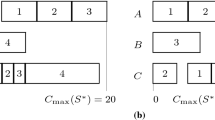Abstract
We investigate the problem of on-line scheduling two-machine open shops with the objective of minimizing the makespan.Jobs arrive independently over time, and the existence of a job is not known until its arrival. In the clairvoyant on-line model, the processing requirement of every job becomes fully known at the arrival of the job, while inthe non-clairvoyant on-line model, this processing requirement is notknown until the job is processed and completed.In both models, scheduling of a job is irrevocable.
We study the two-machine open shop problem for both models in the preemptive and in the non-preemptive version. For each of the four variants, we provide an algorithm that is best possible with respect to the worst-case performance. In the clairvoyant on-line model, the best worst-case performance ratios are 5/4 (preemptive) and 3/2 (non-preemptive), and in the non-clairvoyant on-line model, they are 3/2 (preemptive and non-preemptive).
Similar content being viewed by others
References
V.A. Aksjonov, “A polynomial-time algorithm of approximate solution of a scheduling problem (in Russian),” Upravlyaemye Sistemy, vol. 28, pp. 8–11, 1988.
B. Chen and V.A. Strusevich, “Approximation algorithms for three-machine open shop scheduling,” ORSA Journal on Computing, vol. 5, pp. 321–326, 1993.
B. Chen and G.J. Woeginger, “A study of on-line scheduling two-stage shops,” in Minimax and Applications, D.-Z. Du and P.M. Pardalos (Eds.), 1995, pp. 97–107.
T. Gonzalez and S. Sahni, “Open shop scheduling to minimize finish time,” J. Assoc. Comput. Mach., vol. 23, pp. 665–679, 1976.
E.L. Lawler, J.K. Lenstra, and A.H.G. Rinnooy Kan, “Minimizing maximum lateness in a two-machine open shop,” Mathematics of Operations Research, vol. 6, pp. 153–158, 1981.
E.L. Lawler, J.K. Lenstra, A.H.G. Rinnooy Kan, and D.B. Shmoys, “Sequencing and scheduling: algorithms and complexity,” in Handbooks in Operations Research and Management Science, North Holland, 1993, vol. 4, pp. 445–522.
R. Motwani, S. Phillips, and E. Torng, “Non-clairvoyant scheduling,” Theoretical Computer Science, vol. 130, pp. 17–47, 1994.
D.B. Shmoys, C. Stein, and J. Wein, “Improved Approximation Algorithms for Shop Scheduling Problems,” Proc. of the 2nd ACM-SIAM Symposium on Discrete Algorithms, 1991, pp. 148–157.
Author information
Authors and Affiliations
Rights and permissions
About this article
Cite this article
Chen, B., Vestjens, A.P. & Woeginger, G.J. On-Line Scheduling of Two-Machine Open Shops Where Jobs Arrive Over Time. Journal of Combinatorial Optimization 1, 355–365 (1998). https://doi.org/10.1023/A:1009786526733
Issue Date:
DOI: https://doi.org/10.1023/A:1009786526733




